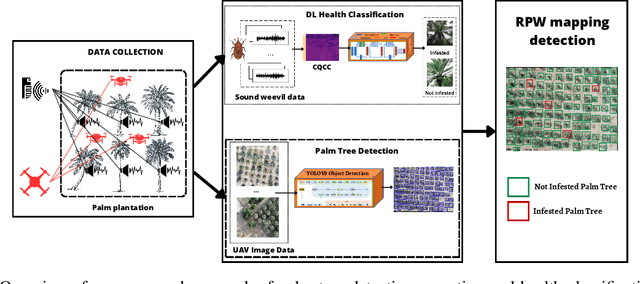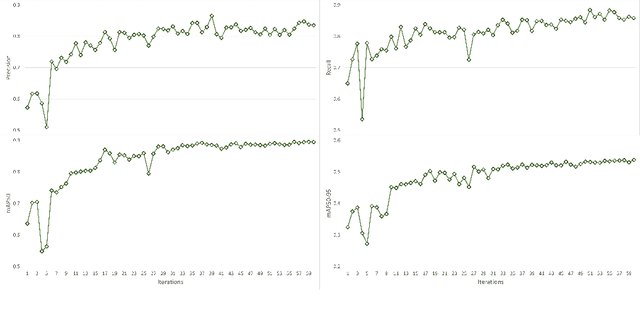Ayyub Alzahem
An Effective Weight Initialization Method for Deep Learning: Application to Satellite Image Classification
Jun 01, 2024Abstract:The growing interest in satellite imagery has triggered the need for efficient mechanisms to extract valuable information from these vast data sources, providing deeper insights. Even though deep learning has shown significant progress in satellite image classification. Nevertheless, in the literature, only a few results can be found on weight initialization techniques. These techniques traditionally involve initializing the networks' weights before training on extensive datasets, distinct from fine-tuning the weights of pre-trained networks. In this study, a novel weight initialization method is proposed in the context of satellite image classification. The proposed weight initialization method is mathematically detailed during the forward and backward passes of the convolutional neural network (CNN) model. Extensive experiments are carried out using six real-world datasets. Comparative analyses with existing weight initialization techniques made on various well-known CNN models reveal that the proposed weight initialization technique outperforms the previous competitive techniques in classification accuracy. The complete code of the proposed technique, along with the obtained results, is available at https://github.com/WadiiBoulila/Weight-Initialization
Feature Fusion for Improved Classification: Combining Dempster-Shafer Theory and Multiple CNN Architectures
May 23, 2024



Abstract:Addressing uncertainty in Deep Learning (DL) is essential, as it enables the development of models that can make reliable predictions and informed decisions in complex, real-world environments where data may be incomplete or ambiguous. This paper introduces a novel algorithm leveraging Dempster-Shafer Theory (DST) to integrate multiple pre-trained models to form an ensemble capable of providing more reliable and enhanced classifications. The main steps of the proposed method include feature extraction, mass function calculation, fusion, and expected utility calculation. Several experiments have been conducted on CIFAR-10 and CIFAR-100 datasets, demonstrating superior classification accuracy of the proposed DST-based method, achieving improvements of 5.4% and 8.4%, respectively, compared to the best individual pre-trained models. Results highlight the potential of DST as a robust framework for managing uncertainties related to data when applying DL in real-world scenarios.
Early Detection of Red Palm Weevil Infestations using Deep Learning Classification of Acoustic Signals
Aug 30, 2023Abstract:The Red Palm Weevil (RPW), also known as the palm weevil, is considered among the world's most damaging insect pests of palms. Current detection techniques include the detection of symptoms of RPW using visual or sound inspection and chemical detection of volatile signatures generated by infested palm trees. However, efficient detection of RPW diseases at an early stage is considered one of the most challenging issues for cultivating date palms. In this paper, an efficient approach to the early detection of RPW is proposed. The proposed approach is based on RPW sound activities being recorded and analyzed. The first step involves the conversion of sound data into images based on a selected set of features. The second step involves the combination of images from the same sound file but computed by different features into a single image. The third step involves the application of different Deep Learning (DL) techniques to classify resulting images into two classes: infested and not infested. Experimental results show good performances of the proposed approach for RPW detection using different DL techniques, namely MobileNetV2, ResNet50V2, ResNet152V2, VGG16, VGG19, DenseNet121, DenseNet201, Xception, and InceptionV3. The proposed approach outperformed existing techniques for public datasets.
Sustainable Palm Tree Farming: Leveraging IoT and Multi-Modal Data for Early Detection and Mapping of Red Palm Weevil
Jun 29, 2023



Abstract:The Red Palm Weevil (RPW) is a highly destructive insect causing economic losses and impacting palm tree farming worldwide. This paper proposes an innovative approach for sustainable palm tree farming by utilizing advanced technologies for the early detection and management of RPW. Our approach combines computer vision, deep learning (DL), the Internet of Things (IoT), and geospatial data to detect and classify RPW-infested palm trees effectively. The main phases include; (1) DL classification using sound data from IoT devices, (2) palm tree detection using YOLOv8 on UAV images, and (3) RPW mapping using geospatial data. Our custom DL model achieves 100% precision and recall in detecting and localizing infested palm trees. Integrating geospatial data enables the creation of a comprehensive RPW distribution map for efficient monitoring and targeted management strategies. This technology-driven approach benefits agricultural authorities, farmers, and researchers in managing RPW infestations and safeguarding palm tree plantations' productivity.
Unlocking the Potential of Medical Imaging with ChatGPT's Intelligent Diagnostics
May 12, 2023Abstract:Medical imaging is an essential tool for diagnosing various healthcare diseases and conditions. However, analyzing medical images is a complex and time-consuming task that requires expertise and experience. This article aims to design a decision support system to assist healthcare providers and patients in making decisions about diagnosing, treating, and managing health conditions. The proposed architecture contains three stages: 1) data collection and labeling, 2) model training, and 3) diagnosis report generation. The key idea is to train a deep learning model on a medical image dataset to extract four types of information: the type of image scan, the body part, the test image, and the results. This information is then fed into ChatGPT to generate automatic diagnostics. The proposed system has the potential to enhance decision-making, reduce costs, and improve the capabilities of healthcare providers. The efficacy of the proposed system is analyzed by conducting extensive experiments on a large medical image dataset. The experimental outcomes exhibited promising performance for automatic diagnosis through medical images.
A Deep Learning-based Approach for Real-time Facemask Detection
Oct 17, 2021



Abstract:The COVID-19 pandemic is causing a global health crisis. Public spaces need to be safeguarded from the adverse effects of this pandemic. Wearing a facemask becomes one of the effective protection solutions adopted by many governments. Manual real-time monitoring of facemask wearing for a large group of people is becoming a difficult task. The goal of this paper is to use deep learning (DL), which has shown excellent results in many real-life applications, to ensure efficient real-time facemask detection. The proposed approach is based on two steps. An off-line step aiming to create a DL model that is able to detect and locate facemasks and whether they are appropriately worn. An online step that deploys the DL model at edge computing in order to detect masks in real-time. In this study, we propose to use MobileNetV2 to detect facemask in real-time. Several experiments are conducted and show good performances of the proposed approach (99% for training and testing accuracy). In addition, several comparisons with many state-of-the-art models namely ResNet50, DenseNet, and VGG16 show good performance of the MobileNetV2 in terms of training time and accuracy.
 Add to Chrome
Add to Chrome Add to Firefox
Add to Firefox Add to Edge
Add to Edge